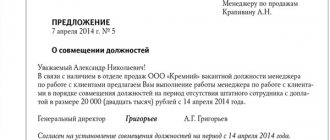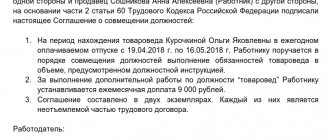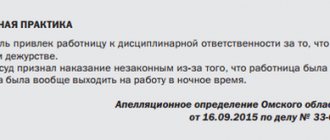Part-time work does not entail for employees any restrictions on the duration of the annual basic paid leave, calculation of length of service and other labor rights. However, in case of part-time employment, remuneration is made in proportion to the time worked or depending on the amount of work performed by the employee. At the same time, the working hours can be defined in different ways (shortened working day or week, or even a mixed version).
In proportion to the time worked it is
Accordingly, settlements with the employee must be made using various algorithms.
First of all, we note that the monthly salary of an employee who has fully worked the standard working hours for the specified period cannot be lower than the minimum wage (Article 133 of the Labor Code). At the same time, according to Art. 133.1 of the Labor Code in a subject of the Russian Federation, a regional agreement may also establish the amount of the minimum wage for employees of the region, with the exception of employees of organizations financed from the federal budget. In any case, the regional minimum wage cannot be lower than the federal minimum. Accordingly, if a region has its own minimum wage, then the salary for a fully worked month cannot be lower than this regional minimum wage. There is only one exception to this rule - when the employer refused to join the agreement on the regional minimum wage (Part 3 of Article 133 and Part 9 of Article 133.1 of the Labor Code). Be that as it may, the lower limit for the amount of wages in the form of the minimum wage (federal or regional, if established by the law of the subject) refers to wages for a fully worked month. In the case when we are talking about part-time employment, then by virtue of Art. 93 of the Labor Code, remuneration is made in proportion to the time worked. Accordingly, the minimum wage is also subject to a proportional reduction.
Partial operating mode
According to Art. 93 of the Labor Code, by agreement between the employee and the employer, a part-time working day (shift) or a part-time working week can be established both upon hiring and subsequently. At the same time, the relevant order, as well as the employment contract (additional agreement to the employment contract), must specify the question in what mode the employee will work. After all, this directly determines how the employee will need to calculate his salary for the time worked. There can be three options here: 1) part-time; 2) part-time work week; 3) part-time work with a shortened work week. Note! The employer is obliged to keep records of the time actually worked by each employee (Part 4 of Article 91 of the Labor Code). For these purposes, you can use your own developed time sheet form or use the unified forms T-12 “Working time sheet and calculation of wages” or T-13 “Working time sheet” (approved by Resolution of the State Statistics Committee of January 5, 2004 No. N 1). It’s easier, of course, to use a unified form. The only thing I would like to emphasize is that if part-time working hours are introduced at the initiative of the employer, then in such situations “unified” codes are used - “NS” or “25”. There are no separate codes for cases where an employee works part-time on his own initiative. Therefore, you should either use the usual codes - “I” or “01”, or develop codes yourself.
Part time
This mode of work assumes that the length of the working week remains unchanged, and the number of hours worked per day decreases.
Example 1. Romashka LLC has an eight-hour working day with a five-day working week. Salary of manager Ivanov I.I. equal to 45,000 rubles. From October 1, 2021, Ivanov was transferred to part-time work - in accordance with the agreement with the employer, he was given a 6-hour working day while maintaining a five-day working week. It is established that wages are paid in proportion to the time worked. October 2021 Ivanov worked fully (was not sick, did not take vacation, time off, etc.). For October, the accountant will calculate his salary as follows: according to the production calendar in October 2021, 21 working days (with a five-day working week) and 168 working hours (with a 40-hour working day). Ivanov worked 126 working hours (21 days x 6 hours). Accordingly, for October he should receive a salary in the amount of 33,750.36 rubles. (RUB 45,000: 168 h x 126 h).
Partial work week
A part-time working week means that an employee has additional working days off. At the same time, the working hours remain normal.
Example 2. Gvozdika LLC has an eight-hour working day with a five-day working week. Salary of driver Petrov P.P. equal to 40,000 rubles. From October 1, 2021, Petrov, by agreement with the employer, was transferred to a part-time working week, in which he was given an additional day off per week - Wednesday. It is established that wages are paid in proportion to the time worked. October 2021 Petrov worked fully (was not sick, did not take vacation, time off, etc.). For October, the accountant will calculate his salary as follows: in October 2021, 21 working days (with a five-day working week). However, in accordance with his work schedule, Petrov worked 17 working days (in October 2021, he had four additional days off, which fell on Wednesdays - the 5th, 12th, 19th and 26th). For October, Petrov should receive a salary in the amount of 32,380.92 rubles. (RUB 40,000: 21 days x 17 days).
"Mixed" option
The Labor Code does not prohibit employees from establishing a part-time work schedule, reducing both the length of the working week and the length of the working day.
Example 3. Buttercup LLC has an eight-hour working day with a five-day working week. Salary of manager Sokolova S.S. equal to 50,000 rubles. From October 1, 2021, Sokolova, by agreement with the employer, was transferred to part-time working hours: - the working day is 6 hours; — the length of the working week is 4 days with an additional day off — Wednesday. October 2021 Sokolova worked fully (didn’t get sick, didn’t take vacation, time off, etc.). For October, the accountant will calculate her salary as follows: in October 2021, 21 working days (with a five-day working week) and 168 working hours (with a 40-hour working day). Sokolova worked 17 days in October. 6 hours each, that is, 102 working hours. For October, Sokolova should receive a salary of 30,357.24 rubles. (RUB 50,000: 168 hours x 102 hours).
Payment is proportional to the amount of work completed
Payment in proportion to time worked means that the employee’s salary does not depend on the number of days or hours worked, but on the amount of work performed. For example, if it is established that for each apron sewn, a seamstress-minder is paid 100 rubles, and per month she sewed 250 units of such aprons during a part-time work week or shift, then her salary for this month will be 25,000 rubles.
Option 1: Using the “Combination of Positions” document
Filling out the document “Combining positions”
Let's create a document Combination of positions (Salary - Change in employee pay - Combination of positions). The details Combination with indicate 01/15/2018. Since the payment for the combination is assigned from the payroll of the replaced employee, we set the Calculate by payroll checkbox Amount of additional payment . In the Combination of Positions , it is not possible to indicate how many hours employee Astrov worked for employee Kashtanov, but you can, by entering the percentage of additional payment, indicate that on January 15 the employee will receive payment not for 8, but only for 4 hours. To do this, enter the value of % of the payroll of I.I. Kashtanov. , calculating the percentage of additional payment as follows: 4 (hours worked by Astrov) / 8 (hours worked according to Kashtanov’s schedule) * 100% = 50%
Calculation of surcharge for combination
Since, according to the terms of the task, the Additional payment for combined work is calculated based on the salary being replaced , it turns out that for 4 hours of work, employee Astrov should receive the following amount.
Let's calculate the amounts of the Additional Payment for Combination, which should be:
20,000 (Kashtanov’s salary) / 136 (standard hours according to Kashtanov’s schedule) * 4 (number of hours worked by Astrov) = 588.24 rubles.
Due to the fact that when using the Combination of Positions , it is not possible to indicate how many hours employee Astrov worked performing Kashtanov’s duties, in the Calculation of Salaries and Contributions , the number of hours is adjusted according to the schedule of the replaced employee, i.e. 8 ocloc'k. At the same time, the additional payment for combining positions and performing duties is equal to the calculated amount - 588.24 rubles. at the expense of payroll specified in the Combination of Positions document – 50%.
As a result, the document Calculation of salaries and contributions reflects the following calculation for Additional payment for combining positions and performing duties :
20,000 (salary of the replaced employee) * 50% (percentage of additional payment from the payroll of the replaced employee) / 136 (standard hours according to the schedule of the replaced employee) * 8 (number of hours per day of replacement according to the schedule of the replaced employee) = 588.24 rubles.
Payroll calculation for part-time work
The employer is responsible for correctly planning the shift schedule and providing the employee with the work stipulated by the employment contract. Due to the fact that it is the employer who does not fulfill the terms of the employment contract and does not provide the employee with the opportunity to fulfill the standard working hours, he is obliged to compensate the employee for losses incurred.
In this case, remuneration should be made in an amount not lower than the average salary of the employee, calculated in proportion to the actual time worked.
So, if the accounting period is a month, the standard hours for the month in accordance with the law were 170 hours, but the employee worked only 162 hours according to the schedule, then (the situation of the applicant):
— payment based on the established salary is made for 162 hours,
— payment for 8 hours (170-162) is made in an amount not lower than the average hourly wage for the 12 calendar months preceding the paid month.
It should also be noted that by agreement with the employee, he can be assigned part-time work both upon hiring and subsequently. In this case, when working on a part-time basis, the employee’s payment is made in proportion to the time he worked or depending on the amount of work he performed.
At the same time, for employees working part-time (shift) and (or) part-time week, the normal number of working hours for the accounting period is correspondingly reduced.
If the employer violates labor legislation, the employee has the right to file a statement (in writing or electronically) with the state labor inspectorate at the employer’s location, with the prosecutor’s office, or directly with a statement of claim in court at the location of the organization or at his place of residence.
It should be noted that the period for an employee to apply to court for resolution of an individual labor dispute is 3 months from the day he learned or should have learned about a violation of his rights, and for disputes about dismissal - within one month from the date of delivery him copies of the dismissal order or from the date of issue of the work book.
To resolve an individual labor dispute regarding non-payment or incomplete payment of wages and other payments due to an employee, he has the right to go to court within one year from the date of the established deadline for payment of these amounts, including in the case of non-payment or incomplete payment of wages and other payments due to an employee upon dismissal.
The state fee when considering labor disputes by the courts is not collected.
At the same time, the lawyer recommends that before contacting regulatory and supervisory authorities, prosecutors or courts, contact the employer directly to resolve any disagreements that have arisen.
Legal basis: In accordance with Article 22 of the Labor Code of the Russian Federation (hereinafter referred to as the Labor Code of the Russian Federation), the employer is obliged to provide employees with work stipulated by the employment contract.
Based on Article 91 of the Labor Code of the Russian Federation, working time is the time during which an employee, in accordance with the internal labor regulations and the terms of the employment contract, must perform labor duties, as well as other periods of time that, in accordance with this Code, other federal laws and other regulatory legal acts of the Russian Federation relate to working time.
Article 104 of the Labor Code of the Russian Federation establishes that when, due to the conditions of production (work) of an individual entrepreneur, in the organization as a whole, or when performing certain types of work, the established for this category of workers (including workers engaged in work with hazardous and (or) hazardous working conditions) daily or weekly working hours, it is allowed to introduce summarized recording of working hours so that the duration of working hours for the accounting period (month, quarter and other periods) does not exceed the normal number of working hours. The accounting period cannot exceed one year, and for recording the working time of workers engaged in work with harmful and (or) dangerous working conditions - three months.
The normal number of working hours for the accounting period is determined based on the weekly working hours established for this category of workers.
In accordance with Article 155 of the Labor Code of the Russian Federation, in case of failure to comply with labor standards or failure to fulfill labor (official) duties through the fault of the employer, remuneration is made in an amount not lower than the average salary of the employee, calculated in proportion to the time actually worked.
According to Article 139 of the Labor Code of the Russian Federation, in any mode of operation, the average salary of an employee is calculated based on the salary actually accrued to him and the time actually worked by him for the 12 calendar months preceding the period during which the employee retains the average salary. In this case, a calendar month is considered to be the period from the 1st to the 30th (31st) day of the corresponding month inclusive (in February - to the 28th (29th) day inclusive).
According to clause 13 of the Regulations on the specifics of the procedure for calculating average wages, approved. by Decree of the Government of the Russian Federation No. 922 dated December 24, 2007, when determining the average earnings of an employee for whom a summarized recording of working time is established, except in cases of determining the average earnings for paying for vacations and paying compensation for unused vacations, the average hourly earnings are used.
Average hourly earnings are calculated by dividing the amount of wages actually accrued for hours worked in the billing period, including bonuses and remunerations taken into account in accordance with paragraph 15 of the Regulations, by the number of hours actually worked during this period.
Average earnings are determined by multiplying average hourly earnings by the number of working hours according to the employee’s schedule in the period subject to payment.
In accordance with Article 93 of the Labor Code of the Russian Federation, by agreement of the parties to the employment contract, an employee, both upon hiring and subsequently, may be assigned part-time working hours (part-time work (shift) and (or) part-time work week, including with a split working day into parts). Part-time working hours can be established either without a time limit or for any period agreed upon by the parties to the employment contract.
At the same time, in accordance with Art. 104 of the Labor Code of the Russian Federation for employees working part-time (shift) and (or) part-time week, the normal number of working hours for the accounting period is correspondingly reduced.
In accordance with Art. 356 of the Labor Code of the Russian Federation The State Labor Inspectorate in the Urals carries out federal state supervision over compliance with labor legislation and other regulatory legal acts containing labor law norms, through inspections and issuing mandatory orders to eliminate violations.
In accordance with the Federal Law of January 17, 1992 No. 2202-1 “On the Prosecutor’s Office of the Russian Federation,” the main task of the prosecutor’s office is to exercise general supervision over compliance with the law, i.e. The prosecutor's office is not a specialized body for supervision and control in the field of labor. However, since labor legislation is part of the general legislative system, the prosecutor's office is authorized to exercise supervision in this area as well.
Based on Art. 392 of the Labor Code of the Russian Federation, an employee has the right to apply to the court for resolution of an individual labor dispute within three months from the day he learned or should have learned about a violation of his right, and in disputes about dismissal - within one month from the date he was given a copy of the order dismissal or from the date of issue of the work book.
To resolve an individual labor dispute regarding non-payment or incomplete payment of wages and other payments due to an employee, he has the right to go to court within one year from the date of the established deadline for payment of these amounts, including in the case of non-payment or incomplete payment of wages and other payments due to an employee upon dismissal.
In accordance with Articles 28, 29 of the Code of Civil Procedure, the claim is brought to the court at the place of residence of the defendant. A claim against an organization is filed in court at the location of the organization. Claims for restoration of labor rights may also be brought to the court at the plaintiff’s place of residence.
Arbitrage practice.
The Dzerzhinsky District Court of Perm, in Decision No. 2-2196/14 dated August 29, 2014, stated that if, according to a shift schedule drawn up in advance by the employer (based on the results of the accounting period) in the organization, the working time of an employee for whom a summarized recording of working time is established, less than the norm, then there is a deficiency due to the fault of the employer. From Art. 155 of the Labor Code of the Russian Federation it follows that responsibility for the employee’s failure to comply with labor standards lies with the employer and he must reimburse the employee the average wage for the time not worked.
Consultation was given in November 2021 as part of the Republican competition “Professional Lawyer 2017”.
Consultant - Rinata Sergeevna Shaydullina, chief state labor inspector of the department of state supervision of labor protection of the State Labor Inspectorate in the Udmurt Republic
Actual time worked
Actual time worked is the time an employee performs his direct labor duties and work.
It is possible to determine a remuneration system in which wages are calculated for the time actually worked for employees whose work should be assessed based on the days or hours that they actually worked.
It can be:
- employees whose work is difficult to standardize or whose work cannot be accounted for (for example, management, administrative and managerial personnel);
- employees who do not influence the increase in production volume (for example, if the result of work is determined primarily by the productivity of equipment);
- workers whose labor productivity is difficult (impossible) to determine.







